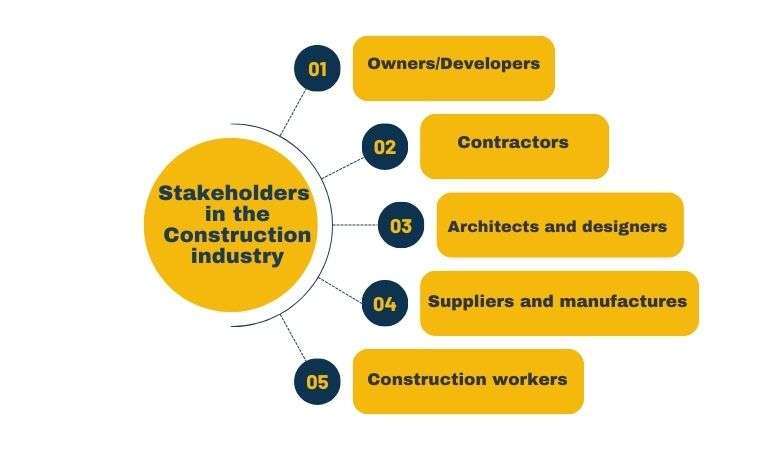The construction industry refers to the industrial branch of manufacturing and trade related to building, repairing, renovating, and maintaining infrastructure. the construction process involves several stages. It starts with project planning and feasibility studies, where the scope, budget, and schedule are determined. The design phase follows, where architects, engineers, and other professionals create detailed plans and specifications. Once the designs are finalized, the construction phase begins, involving the actual building and installation of materials, equipment, and systems.

Table of Contents
An overview of construction industry.
The construction industry is a vital sector that encompasses a wide range of activities related to the planning, design, construction, and maintenance of buildings, infrastructure, and other physical structures. It plays a crucial role in shaping the urban landscape, providing essential facilities, and driving economic growth. The construction industry faces various challenges, including tight schedules, budget constraints, safety concerns, environmental impact, and the adoption of new technologies.
Advancements in construction techniques, materials, and equipment have led to innovative approaches such as modular construction, green building practices, and the use of digital tools like building information modeling (BIM) to enhance efficiency and sustainability.
The challenges of construction industry.

The construction industry faces several challenges that can impact project timelines, costs, and overall success. here are some common challenges:
- Cost Management: Managing construction costs is a significant challenge. Material prices, labor wages, and equipment expenses can fluctuate, making it difficult to stay within budget.
- Project delays: Delays can occur due to various factors, such as adverse weather conditions, labor shortages, permit, and regulatory issues, or unexpected technical problems.
- Workforce shortage: The construction industry often faces a shortage of skilled labor. This shortage can be attributed to an aging workforce and a lack of interest among younger generations.
- Regulatory compliance: The construction industry is subject to numerous regulations and codes that carry across regions. Compliance with building codes, and safety standards can be time-consuming.
- Quality control: Maintaining high-quality standards throughout the construction process is essential. Poor quality can lead to rework, delays, and disputes.
The construction industry belongs to the Business
- Residential construction: This involves the construction of houses, apartments, condominiums, and other residential buildings.
- Commercial construction: It includes the construction of office buildings, shopping malls, hotels, restaurants, and other commercial structures.
- Industrial construction: This sector focuses on the construction of factories, warehouses, power plants, refineries, and other industrial facilities.
- Infrastructure construction: This involves the development of public infrastructure such as roads, bridges, tunnels, airports, seaports, railways, and water supply systems.
- Heavy construction: It encompasses large-scale projects such as dams, highways, bridges, tunnels, and other significant civil engineering projects.
The stakeholders in construction industry.

- Clients/Owners: These are the individuals or organizations that initiate the construction project and have it built to meet their specific needs. They provide the funding and determine the project’s objectives.
- Contractors: Construction companies or firms that are responsible for executing the construction project. They manage the construction process, coordinate subcontractors, and ensure the project is completed on time and within budget.
- Architects and Designers: They are responsible for designing the project and creating the architectural and structural plans. They work closely with the clients to understand their requirements and translate them into a feasible design.
- Suppliers and Manufacturers: Companies that provide construction materials, equipment, and machinery necessary for the project. They play a crucial role in the supply chain and delivery of materials to the construction site.
- Construction Workers: Skilled laborers, supervisors, and workers involved in the actual construction work. They have a direct interest in the project’s success and safe working conditions.
Improve productivity in construction industry.
- Effective Project Planning: Thoroughly plan the project from start to finish, including defining project goals, creating a realistic timeline, and allocating resources appropriately. This reduces potential delays, optimizes resource utilization, and improves coordination.
- Embrace Technology: Implement construction management software, project management tools, and Building Information Modeling (BIM) systems to streamline communication, collaboration, and document management. Technology can automate processes, track progress, and improve overall project efficiency.
- Training and Skill Development: Invest in training programs and professional development opportunities for construction workers and staff. Enhancing their skills and knowledge will improve their productivity, efficiency, and the quality of work they deliver.
- Prefabrication and Modular Construction: Utilize off-site prefabrication and modular construction methods where feasible. This approach allows for simultaneous construction activities, reduces on-site labor requirements, and improves construction speed and quality.
- Lean Construction Principles: Implement lean construction principles and techniques such as just-in-time delivery, waste reduction, continuous improvement, and value stream mapping. These strategies help identify and eliminate non-value-adding activities, minimize material waste, and optimize workflows.he
Conclusion:
The construction industry is a complex and vital sector that encompasses various stakeholders and plays a significant role in shaping our built environment. It involves a range of activities, from planning and design to execution and project delivery. The industry faces challenges such as productivity issues, cost overruns, and schedule delays.
Content Writer at DM Valid
Asifa Khanum is a content specialist at DM Valid. I fulfilled roles in marketing that shaped her interest in finding innovative solutions to modern-day problems.


